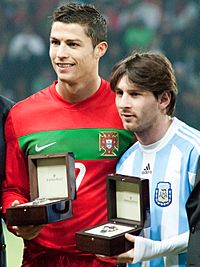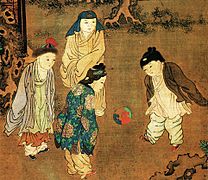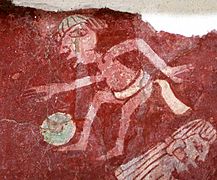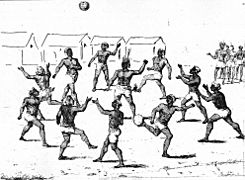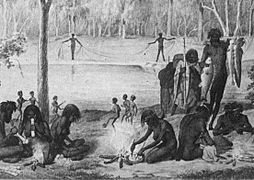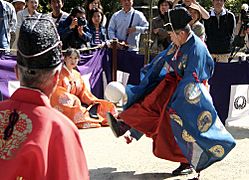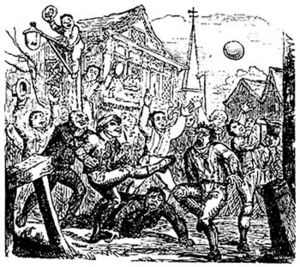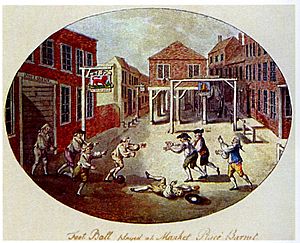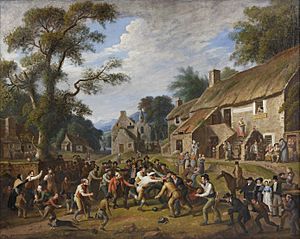Football facts for kids

Football is a word which could mean one of several sports. The best-known type of football is association football. This is called "soccer" in North America, South Africa, and Australia to avoid confusion with other types of football that are commonly played there.
The name football comes from the two words 'foot' and 'ball'. It is named football because the players of the game walk and often run (on their feet) while playing, as opposed to (for example) polo where the players ride horses. Football is played using a ball, also called a 'football', that is usually shaped like a sphere or an ellipsoid. The ball is often kicked with the foot, but depending on the game, it can also be hit using other parts of the body (in association football) and handling the ball is a part of some other sports known as 'football'.
Some elements of football have been seen in many countries, dating back to the second and third century AD in China. The modern games of both rugby football and association football comes from 19th-century England. Kicking a ball goes back to the Middle Ages. Association football spread to many other parts of Europe, and was brought to the rest of the world with colonization. Today, it is the most popular sport in the world and many people watch it on television, especially the FIFA World Cup that happens every four years.
Every year there is a Football Club Competition called as Champions League. All the qualified big teams take part. At the end, we have one winner who takes the prestigious UEFA trophy. All big players play for their own teams. Some big players who take part every year are Mbappe, Ronaldo, Messi, Dybala, Neymar and many more
Contents
Early history
Ancient games
Ancient China
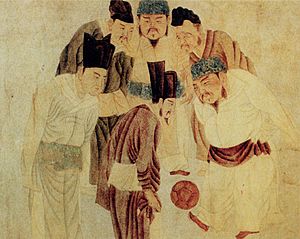
The Chinese competitive game cuju (蹴鞠) resembles modern association football (soccer), descriptions appear in a military manual dated to the second and third centuries BC. It existed during the Han dynasty and possibly the Qin dynasty, in the second and third centuries BC. The Japanese version of cuju is kemari (蹴鞠), and was developed during the Asuka period. This is known to have been played within the Japanese imperial court in Kyoto from about 600 AD. In kemari several people stand in a circle and kick a ball to each other, trying not to let the ball drop to the ground (much like keepie uppie).
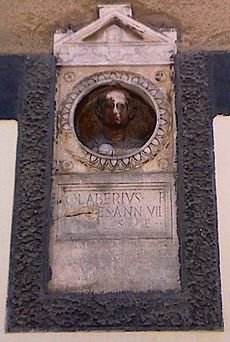
Ancient Greece and Rome
The Ancient Greeks and Romans are known to have played many ball games, some of which involved the use of the feet. The Roman game harpastum is believed to have been adapted from a Greek team game known as "ἐπίσκυρος" (Episkyros) or "φαινίνδα" (phaininda), which is mentioned by a Greek playwright, Antiphanes (388–311 BC) and later referred to by the Christian theologian Clement of Alexandria (c. 150 – c. 215 AD). These games appear to have resembled rugby football. The Roman politician Cicero (106–43 BC) describes the case of a man who was killed whilst having a shave when a ball was kicked into a barber's shop. Roman ball games already knew the air-filled ball, the follis. Episkyros is recognised as an early form of football by FIFA.
Native Americans
There are a number of references to traditional, ancient, or prehistoric ball games, played by indigenous peoples in many different parts of the world. For example, in 1586, men from a ship commanded by an English explorer named John Davis, went ashore to play a form of football with Inuit in Greenland. There are later accounts of an Inuit game played on ice, called Aqsaqtuk. Each match began with two teams facing each other in parallel lines, before attempting to kick the ball through each other team's line and then at a goal. In 1610, William Strachey, a colonist at Jamestown, Virginia recorded a game played by Native Americans, called Pahsaheman. Pasuckuakohowog, a game similar to modern-day association football played amongst Amerindians, was also reported as early as the 17th century.
Games played in Mesoamerica with rubber balls by indigenous peoples are also well-documented as existing since before this time, but these had more similarities to basketball or volleyball, and no links have been found between such games and modern football sports. Northeastern American Indians, especially the Iroquois Confederation, played a game which made use of net racquets to throw and catch a small ball; however, although it is a ball-goal foot game, lacrosse (as its modern descendant is called) is likewise not usually classed as a form of "football."
Oceania
On the Australian continent several tribes of indigenous people played kicking and catching games with stuffed balls which have been generalised by historians as Marn Grook (Djab Wurrung for "game ball"). The earliest historical account is an anecdote from the 1878 book by Robert Brough-Smyth, The Aborigines of Victoria, in which a man called Richard Thomas is quoted as saying, in about 1841 in Victoria, Australia, that he had witnessed Aboriginal people playing the game: "Mr Thomas describes how the foremost player will drop kick a ball made from the skin of a possum and how other players leap into the air in order to catch it." Some historians have theorised that Marn Grook was one of the origins of Australian rules football.
The Māori in New Zealand played a game called Ki-o-rahi consisting of teams of seven players play on a circular field divided into zones, and score points by touching the 'pou' (boundary markers) and hitting a central 'tupu' or target.
These games and others may well go far back into antiquity. However, the main sources of modern football codes appear to lie in western Europe, especially England.
Turkic peoples
Mahmud al-Kashgari in his Dīwān Lughāt al-Turk, described a game called "tepuk" among Turks in Central Asia. In the game, people try to attack each other's castle by kicking a ball made of sheep leather.
-
A Song dynasty painting by Su Hanchen (c. 1130-1160), depicting Chinese children playing cuju
-
Paint of a Mesoamerican ballgame player of the Tepantitla murals in Teotihuacan
-
A group of indigenous people playing a ball game in French Guiana
-
An illustration from the 1850s of indigenous Australians playing marn grook
Medieval and early modern Europe
The Middle Ages saw a huge rise in popularity of annual Shrovetide football matches throughout Europe, particularly in England. An early reference to a ball game played in Britain comes from the 9th-century Historia Brittonum, attributed to Nennius, which describes "a party of boys ... playing at ball". References to a ball game played in northern France known as La Soule or Choule, in which the ball was propelled by hands, feet, and sticks, date from the 12th century.
The early forms of football played in England, sometimes referred to as "mob football", would be played in towns or between neighbouring villages, involving an unlimited number of players on opposing teams who would clash en masse, struggling to move an item, such as inflated animal's bladder to particular geographical points, such as their opponents' church, with play taking place in the open space between neighbouring parishes. The game was played primarily during significant religious festivals, such as Shrovetide, Christmas, or Easter, and Shrovetide games have survived into the modern era in a number of English towns (see below).
The first detailed description of what was almost certainly football in England was given by William FitzStephen in about 1174–1183. He described the activities of London youths during the annual festival of Shrove Tuesday:
After lunch all the youth of the city go out into the fields to take part in a ball game. The students of each school have their own ball; the workers from each city craft are also carrying their balls. Older citizens, fathers, and wealthy citizens come on horseback to watch their juniors competing, and to relive their own youth vicariously: you can see their inner passions aroused as they watch the action and get caught up in the fun being had by the carefree adolescents.
Most of the very early references to the game speak simply of "ball play" or "playing at ball". This reinforces the idea that the games played at the time did not necessarily involve a ball being kicked.
An early reference to a ball game that was probably football comes from 1280 at Ulgham, Northumberland, England: "Henry... while playing at ball.. ran against David". There is documented reference that football was played in Ireland in 1308. Another reference to a football game comes in 1321 at Shouldham, Norfolk, England: "[d]uring the game at ball as he kicked the ball, a lay friend of his... ran against him and wounded himself".
In 1314, Nicholas de Farndone, Lord Mayor of the City of London issued a decree banning football in the French used by the English upper classes at the time. A translation reads: "[f]orasmuch as there is great noise in the city caused by hustling over large foot balls [rageries de grosses pelotes de pee] in the fields of the public from which many evils might arise which God forbid: we command and forbid on behalf of the king, on pain of imprisonment, such game to be used in the city in the future." This is the earliest reference to football.
In 1363, King Edward III of England issued a proclamation banning "...handball, football, or hockey; coursing and cock-fighting, or other such idle games", showing that "football" – whatever its exact form in this case – was being differentiated from games involving other parts of the body, such as handball.
A game known as "football" was played in Scotland as early as the 15th century: it was prohibited by the Football Act 1424 and although the law fell into disuse it was not repealed until 1906. There is evidence for schoolboys playing a "football" ball game in Aberdeen in 1633 (some references cite 1636) which is notable as an early allusion to what some have considered to be passing the ball. The word "pass" in the most recent translation is derived from "huc percute" (strike it here) and later "repercute pilam" (strike the ball again) in the original Latin. It is not certain that the ball was being struck between members of the same team. The original word translated as "goal" is "metum", literally meaning the "pillar at each end of the circus course" in a Roman chariot race. There is a reference to "get hold of the ball before [another player] does" (Praeripe illi pilam si possis agere) suggesting that handling of the ball was allowed. One sentence states in the original 1930 translation "Throw yourself against him" (Age, objice te illi).
King Henry IV of England also presented one of the earliest documented uses of the English word "football", in 1409, when he issued a proclamation forbidding the levying of money for "foteball".
There is also an account in Latin from the end of the 15th century of football being played at Caunton, Nottinghamshire. This is the first description of a "kicking game" and the first description of dribbling: "[t]he game at which they had met for common recreation is called by some the foot-ball game. It is one in which young men, in country sport, propel a huge ball not by throwing it into the air but by striking it and rolling it along the ground, and that not with their hands but with their feet... kicking in opposite directions." The chronicler gives the earliest reference to a football pitch, stating that: "[t]he boundaries have been marked and the game had started.
Other firsts in the medieval and early modern eras:
- "a football", in the sense of a ball rather than a game, was first mentioned in 1486. This reference is in Dame Juliana Berners' Book of St Albans. It states: "a certain rounde instrument to play with ...it is an instrument for the foote and then it is calde in Latyn 'pila pedalis', a fotebal."
- a pair of football boots were ordered by King Henry VIII of England in 1526.
- women playing a form of football was first described in 1580 by Sir Philip Sidney in one of his poems: "[a] tyme there is for all, my mother often sayes, When she, with skirts tuckt very hy, with girles at football playes."
- the first references to goals are in the late 16th and early 17th centuries. In 1584 and 1602 respectively, John Norden and Richard Carew referred to "goals" in Cornish hurling. Carew described how goals were made: "they pitch two bushes in the ground, some eight or ten foote asunder; and directly against them, ten or twelue [twelve] score off, other twayne in like distance, which they terme their Goales". He is also the first to describe goalkeepers and passing of the ball between players.
- the first direct reference to scoring a goal is in John Day's play The Blind Beggar of Bethnal Green (performed circa 1600; published 1659): "I'll play a gole at camp-ball" (an extremely violent variety of football, which was popular in East Anglia). Similarly in a poem in 1613, Michael Drayton refers to "when the Ball to throw, And drive it to the Gole, in squadrons forth they goe".
Calcio Fiorentino
In the 16th century, the city of Florence celebrated the period between Epiphany and Lent by playing a game which today is known as "calcio storico" ("historic kickball") in the Piazza Santa Croce. The young aristocrats of the city would dress up in fine silk costumes and embroil themselves in a violent form of football. For example, calcio players could punch, shoulder charge, and kick opponents. Blows below the belt were allowed. The game is said to have originated as a military training exercise. In 1580, Count Giovanni de' Bardi di Vernio wrote Discorso sopra 'l giuoco del Calcio Fiorentino. This is sometimes said to be the earliest code of rules for any football game. The game was not played after January 1739 (until it was revived in May 1930).
Official disapproval and attempts to ban football
There have been many attempts to ban football, from the middle ages through to the modern day. The first such law was passed in England in 1314; it was followed by more than 30 in England alone between 1314 and 1667. Women were banned from playing at English and Scottish Football League grounds in 1921, a ban that was only lifted in the 1970s. Female footballers still face similar problems in some parts of the world.
American football also faced pressures to ban the sport. The game played in the 19th century resembled mob football that developed in medieval Europe, including a version popular on university campuses known as Old division football, and several municipalities banned its play in the mid-19th century. By the 20th century, the game had evolved to a more rugby style game. In 1905, there were calls to ban American football in the U.S. due to its violence; a meeting that year was hosted by American president Theodore Roosevelt led to sweeping rules changes that caused the sport to diverge significantly from its rugby roots to become more like the sport as it is played today.
Types of football
- Association football (soccer)
- American football
- Rugby league football
- Rugby union football
- Gridiron football
- College football
- Touch rugby - Called "touch football" in Australia.
- Canadian football
- Gaelic football
- Australian Rules Football
Images for kids
-
Although the Rugby School (pictured) became famous due to a version that rugby football was invented there in 1823, most sports historians refuse this version stating it is apocryphal
-
Football match in the 1846 Shrove Tuesday in Kingston upon Thames, England
-
Tom Wills, widely regarded as the father of Australian football
-
Wood engraving of an Australian rules football match at the Richmond Paddock, Melbourne, 1866
-
The Tigers of Hamilton, Ontario, circa 1906. Founded 1869 as the Hamilton Foot Ball Club, they eventually merged with the Hamilton Flying Wildcats to form the Hamilton Tiger-Cats, a team still active in the Canadian Football League.
-
The All-Ireland Football Final in Croke Park, 2004
-
An indoor soccer game at an open-air venue in Mexico. The referee has just awarded the red team a free kick.
-
Women's beach soccer game at YBF 2010 in Yyteri Beach, Pori, Finland
-
Griffins RFC Kotka, the rugby union team from Kotka, Finland, playing in the Rugby-7 Tournament in 2013
-
Harrow football players after a game at Harrow School (circa 2005).
See also
 In Spanish: Fútbol (homonimia) para niños
In Spanish: Fútbol (homonimia) para niños


